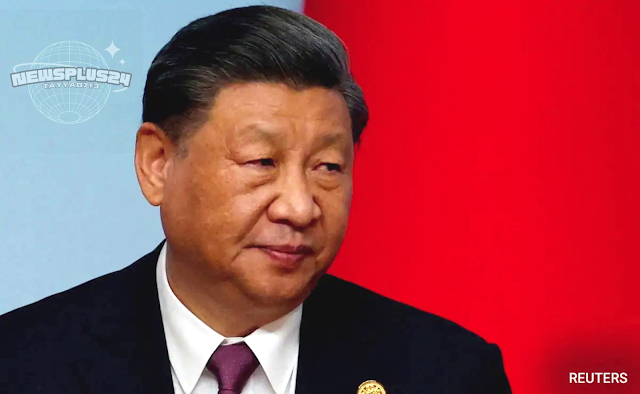Instead of being merely a period of economic frailty, this might signify the gradual fading of an extended era, as expressed.
From Washington: A notable American financial publication has pointed out that China's economy, ranking as the world's second-largest, is presently grappling with severe challenges. The publication asserts that the once successful 40-year growth model is now "inoperative," highlighting that indications of these difficulties extend beyond China's lackluster economic statistics to remote provinces. In a substantial Sunday feature, The Wall Street Journal notes that economists now hold the belief that China is stepping into an era characterized by notably slower growth, exacerbated by unfavorable demographic trends and an expanding rift with the United States and its allied nations. This divide poses a threat to foreign investment and trade.
Rather than a mere interval of economic fragility, this could potentially symbolize the waning of an extensive epoch, the publication remarks.
The financial periodical remarks, "The prevailing economic model is now defunct."
Adam Tooze, a history professor at Columbia University specializing in economic crises, is quoted in the article, stating, "We are observing a shift in what has been the most remarkable trajectory in economic history."
According to the report, the aggregate debt, encompassing liabilities held by various government levels and state-owned corporations, has surged to almost 300 percent of China's GDP by 2022. This surpasses levels in the United States and marks a significant increase from the sub-200 percent recorded in 2012.
Within the halls of power in Beijing, senior officials have acknowledged that the growth pattern from past decades has reached its boundaries, as elaborated in the article.
In a candid speech to a new generation of party leaders the previous year, Chinese President Xi Jinping criticized officials for their reliance on borrowing to fuel economic expansion, the report adds. He cautioned against this approach, stating, "Some individuals believe that development entails investing in projects and scaling up investments," further warning that "one cannot tread the old path with new shoes." However, Xi and his team have made limited progress in deviating from the nation's previous growth model, according to the financial publication.
China's National Bureau of Statistics reported a 5.5 percent year-on-year growth in the country's gross domestic product (GDP) during the first half of 2023. In this period, China's GDP reached 59.3 trillion yuan (approximately 8.3 trillion US dollars), as indicated by NBS data. The second quarter saw a 6.3 percent year-on-year expansion in GDP, reported China's official media, citing the NBS.
Concurrently, China recently reduced its one-year loan prime rate (LPR) by 10 basis points, marking the second adjustment this year. The one-year rate now stands at 3.45 percent, while the five-year rate remains at 4.20 percent. This measure aims to rejuvenate economic growth in the world's second-largest economy, following a similar strategy employed by the United States.
Report Indicates China's Second-Largest Economy in Severe Distress
Xi Jinping Criticizes Officials for Relying on Borrowing for Economic Expansion
Washington: The current state of China's economy, which ranks as the world's second-largest, is one of significant turmoil, as outlined by a prominent American financial publication. This report highlights that the successful growth model that has endured for four decades is now fundamentally flawed. The publication observes that indications of these challenges extend beyond the disappointing economic figures of China to distant provinces. In a substantial Sunday feature, The Wall Street Journal outlines that economists are now of the belief that China is entering a period of notably slower growth, made worse by unfavorable demographic trends and an increasing divide with the United States and its allied nations. This division poses a threat to foreign investment and trade.
Instead of merely being a period of economic fragility, this could potentially signify the fading of a lengthy era, as suggested by the report.
The financial daily states, "The current economic model is no longer functional."
Quoting Adam Tooze, a history professor specializing in economic crises at Columbia University, the article conveys his viewpoint: "We are witnessing a shift in what has been the most remarkable trajectory in economic history," as cited by The Wall Street Journal.
As per the report, the total debt, including obligations held by various government levels and state-owned enterprises, has surged to almost 300 percent of China's GDP by 2022. This surpasses levels in the United States and marks a significant increase from the less than 200 percent recorded in 2012, according to Bank for International Settlements data.
At the corridors of power in Beijing, senior officials have acknowledged that the growth pattern of the past decades has reached its limits, as detailed in the article.
In a candid address to a new generation of party leaders the previous year, Chinese President Xi Jinping criticized officials for relying on borrowing to facilitate economic expansion, the report adds. He cautioned against this approach, stating, "Some individuals believe that development entails investing in projects and scaling up investments," further warning that "one cannot tread the old path with new shoes." However, Xi and his team have made limited progress in deviating from the nation's previous growth model, according to the financial daily.
China's National Bureau of Statistics reported a 5.5 percent year-on-year growth in the country's gross domestic product (GDP) during the first half of 2023. In this period, China's GDP reached 59.3 trillion yuan (approximately 8.3 trillion US dollars), as indicated by NBS data. The second quarter witnessed a 6.3 percent year-on-year expansion in GDP, reported by China's official media, citing the NBS.
In a simultaneous development, China recently reduced its one-year loan prime rate (LPR) for the second time this year, decreasing it by 10 basis points from 3.55 percent to 3.45 percent. The five-year rate remains unchanged at 4.20 percent. This move aims to rejuvenate economic growth in the world's second-largest economy, following a similar strategy employed by the United States.





0 Comments